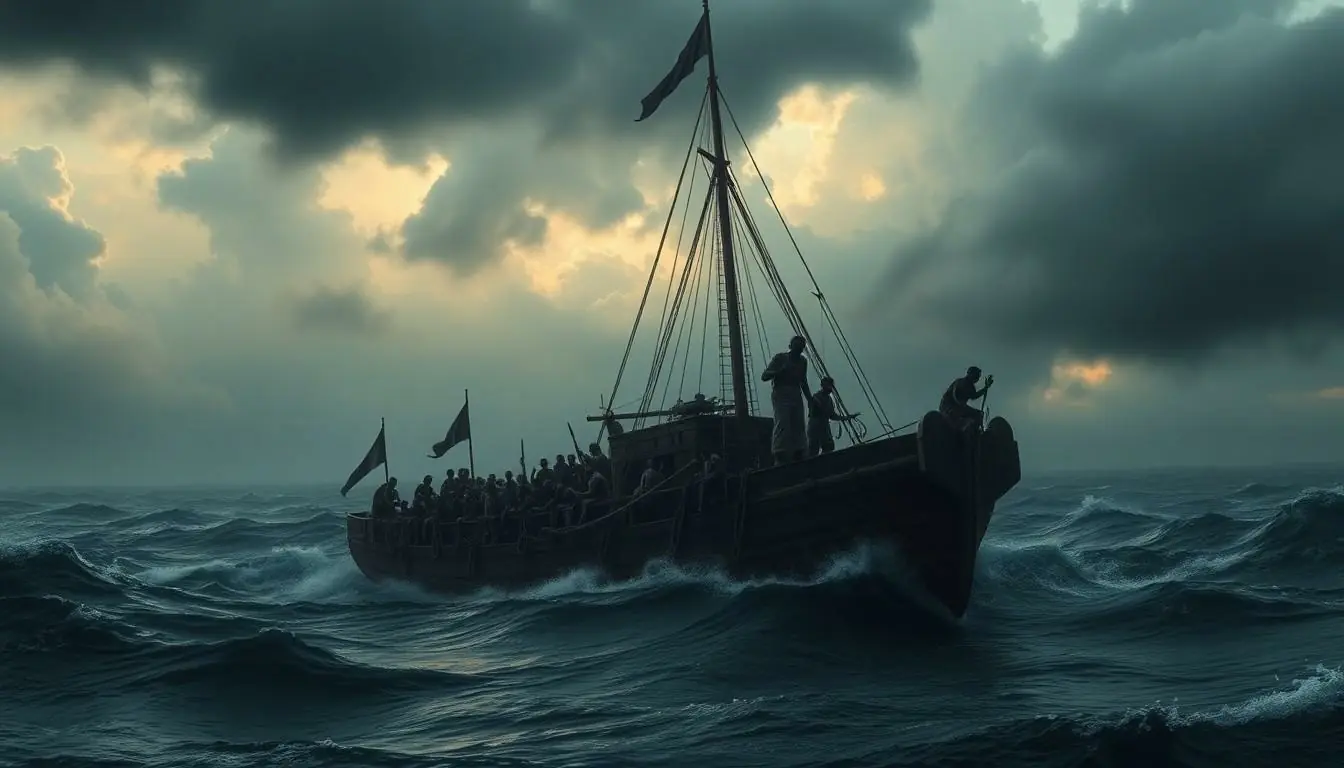Table of Contents
ToggleIn the world of art, few subjects stir as much emotion and conversation as slave ship paintings. These powerful works capture a haunting chapter of history, blending raw emotion with striking visuals. But don’t worry, this isn’t a dry history lesson; it’s an exploration of how creativity can illuminate the darkest corners of our past while sparking important conversations today.
Imagine standing before a canvas that tells a story of resilience, suffering, and survival. Each brushstroke invites viewers to reflect on the human experience, making these paintings both poignant and provocative. From the dramatic use of color to the intricate details that pull you in, slave ship paintings are more than just art; they’re a reminder of where we’ve been and a call to action for where we’re headed. So grab your favorite beverage and prepare to dive into a world where art and history collide in the most compelling way.
Historical Context of Slave Ship Paintings
Slave ship paintings reflect a profound and painful narrative, encapsulating the brutal realities of a dark historical period. These artworks enable deeper conversations about humanity and legacy.
The Transatlantic Slave Trade
The Transatlantic Slave Trade lasted from the late 15th century to the early 19th century, forcibly transporting over 12 million Africans to the Americas. Ships sailed under inhumane conditions, resulting in high mortality rates, with estimates suggesting that nearly 2 million people perished during the journey. Records indicate that these voyages contributed significantly to economic growth in Europe and the Americas, with entire economies relying on enslaved labor. Various nations participated in this devastating trade, creating a complex web of societal implications. Awareness of such statistics informs art created in its aftermath, adding depth and context to slave ship paintings.
Artists and Their Motivations
Artists engage with slave ship paintings driven by a desire to portray suffering and resilience. Many aim to confront viewers with harsh realities, invoking emotional responses. Artists like J.M.W. Turner and others depicted the tragic human experiences aboard these vessels, challenging audiences to reflect on their implications. Beyond mere documentation, these creators intended to provoke thought and foster discussions on social justice. Their works often serve as historical testimonies, preserving memories of those who endured unimaginable hardships. By highlighting these motivations, the legacy of the artwork endures through continued discourse on slavery and its lasting effects.
Analysis of Slave Ship Paintings

Slave ship paintings evoke strong emotional reactions through common themes and imagery. Witnessing the suffering and resilience of enslaved individuals remains prominent in these artworks. Many artists depict harrowing conditions, conveying the intense human experience during the Transatlantic Slave Trade. Dark colors often illustrate despair, while moments of hope may emerge through light or bright elements. Boats frequently serve as central images, symbolizing both the journey and confinement faced by the enslaved.
Symbolism within these paintings requires careful interpretation. For example, water often represents both death and a new beginning. Chains can symbolize oppression and loss of freedom. The presence of human figures highlights the individual stories and tragedies inherent in this historical context. Artists provoke discussions about morality, justice, and humanity’s capacity for both cruelty and compassion. Each layer of meaning in these artworks contributes to deeper understanding, encouraging viewers to reflect critically on historical narratives surrounding slavery.
Notable Slave Ship Paintings
Slave ship paintings capture haunting imagery and profound narratives from history. Each artwork serves as a powerful reminder of the struggles faced by enslaved individuals.
“The Slave Ship” by J.M.W. Turner
“The Slave Ship” created by J.M.W. Turner portrays a ship amidst a stormy sea. The vibrant colors and turbulent waves symbolize the chaos of the Transatlantic Slave Trade. Turner presents enslaved individuals being thrown overboard, showcasing the brutal realities faced during the voyage. Emotional intensity peaks with the depiction of water, representing both despair and the potential for rebirth. This piece invites critical reflection on the relationship between humanity and cruelty. Turner’s aim was to evoke a visceral response, engaging viewers in dialogue about morality and historical accountability.
“The Brookes” by Anonymous
“The Brookes,” an anonymous engraving, illustrates the horrific conditions of the slave ship Brookes. This artwork meticulously depicts the overcrowded quarters where enslaved individuals were confined. The stark layout highlights the inhumane treatment and suffering endured during transits. Each figure’s posture conveys distress and desperation, prompting viewers to confront the dire circumstances. This piece played a significant role in abolitionist movements, raising awareness about the realities of slavery. By doing so, “The Brookes” serves as both a historical document and a catalyst for discussions around human rights and social justice.
Impact on Society and Culture
Slave ship paintings profoundly influence society and culture, serving as a stark reminder of the past while shaping ongoing discussions about human rights and historical memory.
Influence on Art and Literature
Art and literature reflect the haunting themes found in slave ship paintings, inspiring countless works that address suffering and resilience. Their emotional depth resonates across various artistic forms, encouraging dialogues about justice and individual experience. Notable authors and poets, including Toni Morrison and Aimé Césaire, draw upon imagery from these artworks to evoke visceral responses in readers. The influence extends beyond traditional boundaries, encouraging contemporary artists to confront challenging societal narratives. By connecting the past with modern expressions, these paintings inspire a rich tapestry of creativity that explores themes of oppression and hope.
Modern Relevance and Reflections
Modern society still grapples with the implications of slave ship paintings, as discussions surrounding race and justice remain pertinent today. Public exhibitions continue to showcase these artworks, sparking dialogue about historical injustices and their impact on contemporary culture. Activism often incorporates elements from slavery narratives to amplify voices advocating for equality and human rights. Educational programs utilize these paintings to teach about the Transatlantic Slave Trade, fostering critical reflections on history and its consequences. Contemporary artists frequently reinterpret established themes, ensuring that the legacy of these powerful images persists while inspiring future generations to reflect on humanity’s moral responsibilities.
Slave ship paintings serve as profound reminders of a dark history that continues to resonate today. These artworks not only capture the suffering endured by countless individuals but also inspire ongoing conversations about resilience and justice. By engaging with these pieces, viewers are prompted to reflect on the complexities of humanity and the moral responsibilities that arise from historical injustices.
As contemporary society grapples with issues of race and equality, the relevance of slave ship paintings remains significant. They challenge individuals to confront uncomfortable truths while fostering a deeper understanding of the past. Through education and activism, these powerful images encourage future generations to advocate for human rights and ensure that the lessons learned from history are never forgotten.




